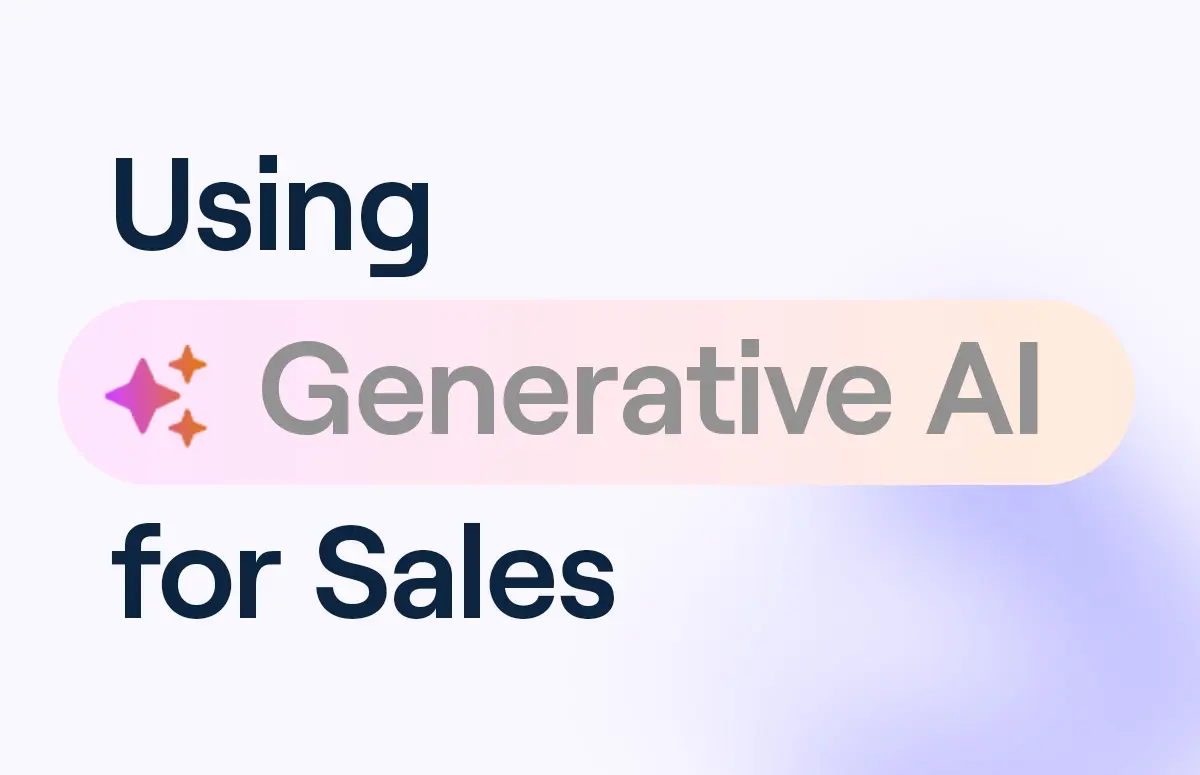What is Account Based Marketing (ABM)? 2025 Strategic Guide
What is account based marketing?
Account based marketing (ABM) is a B2B strategy where marketing and sales work together to target accounts that showcase significant revenue opportunities. Companies use B2B data to create highly personalised marketing campaigns and buyer experiences for each account.
ABM as a marketing approach is individualised, bespoke and tailored. Rather than marketing to a broad number of people or organisations grouped by similar features or circumstances, ABM means you pick out a shorter list of targets and then personalise your approach to exactly suit their needs and requirements.
It’s a good tactic for scaling at SaaS companies, and when we started to execute our own ABM campaigns we saw $300K in pipeline generated in just 8 weeks.
🎧 But wait a sec… Isn’t ABM just good marketing? There’s a lot more to it! Listen to this B2B marketing podcast episode of The Loop for how Cognism approaches account-based marketing.
The 5 benefits of using ABM marketing
Account based marketing can deliver numerous advantages to a business. Several recent studies have highlighted the benefits of ABM tactics:
- A study by Demandbase found that 19% of companies using ABM for at least a year reported more than 30% growth in revenue.
- A SiriusDecisions survey found that 91% of marketers using ABM see a larger deal size, with 25% seeing their deal sizes grow by more than 50%.
- ITSMA found that companies using ABM saw an 84% rise in reputation scores and a 74% improvement in customer relationships.
As well as an enhanced ROI, ABM offers five other core benefits:
1. Less wasted budget
First, it uses resources more efficiently than traditional marketing by focusing on high-value accounts with targeted content. So there’s more marketing budget for strategies like paid and no more time wasted on handling objections.
2. Sales & marketing alignment
Second, it helps to develop a shared mindset between sales and marketing (AKA smarketing), bringing the two teams closer together and streamlining your B2B sales cycle for more efficient sales and marketing funnels.
3. Supports multithreading
Third, ABM supports multithreading. Because sales and marketing are aligned on these target accounts, all the right stakeholders are engaged at the right time across various channels. Whether that be through paid ads, cold calling, or on a landing page.
4. Helps you stand out
It's tough out there right now. Buyers are more educated than ever and un-targeted outreach is everywhere. ABM is a tactic that really helps B2B outreach to stand out. Whether it be using specific company names on your landing pages or through personalised gifting; there's no denying it's far better than the usual "we went to the same uni..." in.
5. Target accounts with a higher ACV
Account based marketing is reserved for accounts with a higher ACV. We've defined three programs based on the revenue potential of target accounts: 1:Many, 1:Few and 1:One ABM. Each program means you dedicate the right number of budget and resources depending on the account grading.
💡You might find Cognism’s account based marketing template helpful.
Real-life ABM examples
Guides are all well and good, but does ABM actually work in practice?
We can tell you that it does!
Here are three account based marketing examples from real businesses:
The cupcake campaign
Cognism use Reachdesk across the entire commercial team:
- SDRs send personalised notes to start a conversation.
- Sales reps deliver content and gift boxes to accelerate deals.
- Customer success send cupcakes to leads who were ghosting.
The cupcake campaign was a perfect illustration of ABM in action. It started with a list of target buyers and the messaging which resonated with each of them. The cupcakes were delivered, and the outcome was exceptional - response rates were 80% when the campaign target was 20%!
Event follow-ups for quantifiable results
Ethan Collins, Growth Lead at SparkForce, explains how they used Cognism to execute a scalable ABM strategy:
"We use Cognism to get a list of companies that fit the ICP criteria, download that, export it to LinkedIn and use that to power our campaigns.”
“Cognism saves us a lot of time and drives higher accuracy. It stops us from targeting irrelevant companies. The value it gives us is the data quality, more than quantity.”
Retargeting lists for an effective ABM approach
James Smith, Business Development Executive at DCSL GuideSmith, explains how they used Cognism’s reliable data to build more robust account based marketing strategies:
“We ran a search through Cognism and found 15,000 relevant companies. Then we filtered these lists to find people who matched us really well.”
“By recycling this data, we created retargeting lists in Cognism and sent them to our Marketing team. They added these contacts to a drip nurture campaign, promoting content and webinars.”
“We’ve seen a big increase in sign-ups and attendees as a result.”
Want to power your account based marketing plan with the best ABM data on the market? Click 👇 to book a demo.
Account based marketing strategies to power your pipeline
Team up marketing and sales
Account based marketing in B2B won’t succeed unless marketing works in conjunction with sales.
However, getting your sales team to work with fewer leads can result in a boatload of anxiety.
Joe Birkedale, CEO of Project36 says:
“If sales don’t understand why ABM is happening and the process and steps a lead has gone through to be classified as a marketing-qualified or sales-qualified lead... Then there’s no importance placed on it.”
“If sales understand what’s happening and why they’re much more likely to jump on those leads and close them. Sales and marketing teams should view closing the lead as a joint effort.”
Start by reassuring them that implementing an ABM program will actually lead to more conversions. Plus, organisations worldwide have been benefiting from this tactic for many years. For example:
- SAP introduced an ABM program with sales and marketing alignment; the result was a $27 million increase in new marketing pipeline opportunities.
- Next Caller grew its revenue by 40% for 16 consecutive months after implementing a sales and marketing alignment plan.
- Successful smarketing helped SalesLoft close a $100k enterprise account.
Then ask them:
- How satisfied are you with the MQLs you’re currently getting from marketing?
- Do you always have the content or resources you need to close?
Most salespeople are frustrated by these two issues: having too many low-quality leads and not having enough useful content. ABM solves these pain points:
- It involves qualifying leads at the start of the sales cycle, not the end.
- It encourages sales and marketing to join forces and pinpoint ready-to-buy leads who have a high probability of converting.
By doing this, these hot leads can be targeted with much more focused and relevant content, making a sale even more likely.
The best way to align marketing and sales around ABM is to demonstrate its value; once everyone is in agreement, it’s time to establish unified marketing and sales goals.
Clearly defined account based marketing goals help focus your efforts. Some questions to consider:
- What do you want to achieve with account-based marketing?
- Are you using ABM to launch a new product?
- Do you want to target a new market?
- Are you looking to upsell existing B2B customers?
Once you know what you want to achieve using account based marketing tactics, establish a timeline and hold weekly or biweekly meetings with your aligned teams to ensure everything stays on track. Joe says:
“When we go about implementing ABM, it’s during the discovery phase that we get together with our sales team, senior and junior, and we drill into their existing sales cycle.”
“We understand the steps and phases that exist, the blockers and objections, the timescales they’re working with, what the customer journey is like, and how long it takes to convert a typical sale from initial inquiry through to conversion. We need to know those things to set KPIs and goals for the campaign.”
Look to your data for key accounts
Now to decide:
Who are the companies you are going to target?
Look at the marketing data you’ve already collected from your target audience and customers.
You’ll likely notice some trends that fit your ideal customer profile. For example, your high-value customers come from one industry, and your highest churn comes from a specific company size.
You might also notice that you’re just missing landing your dream accounts. Does the data explain why? If not, it might be a good idea to have your customer success team check in with missed opportunities to find out why.
Then, look at their competitors. If you are providing value to several companies in a specific industry, it’s likely you can provide value to all the others too.
Once you’ve gathered all this information, the next step is to make a list of target accounts and find out everything you can about them, including who is on their decision-making committees.
In particular, you’ll need to discover the following:
- What are the motivating factors for everyone who would have an input into purchasing your product?
- How can you reach them with the kind of messaging that will make them want to buy?
Identifying key account opportunities requires agreement among stakeholders. Joe’s advice: Make sure everyone agrees on which prospects to target and how many are realistic.
“You need to be realistic with what your program can achieve, what you can handle, and how far your budgets can reach. Start small, always. Prove the account based marketing model and then scale. If you scale up too soon, you’ll drown in data, and the campaign will stumble.”
“Most clients aim for 1-to-Few ABM, which is typically 20 accounts with approximately three decision-makers in each.”
Choose the best digital channels
Content for your ABM campaigns should be diverse enough to be used on all social platforms. At Cognism, we like to create different messaging for each platform to ensure that our audiences don’t get bored of seeing the same messaging following them from channel to channel.
Decide where your B2B customers spend most of their time, and create a content marketing strategy to support each. Owen Steer, ABM Specialist at Punch, talks about the importance of this planning right from the get-go:
“I always say that ABM is 80% setup, 20% execution. There are no strict guidelines for how long it takes to work through the strategic setup of your ABM program...”
“But you will notice that due diligence in getting the setup right in the beginning will be reflected in your success.”
Plan personalised content and messaging
A good account based marketing strategy involves creating valuable content that helps solve your customer’s most pressing issues.
Each piece of content you create should resonate with the individuals who have input into the buying decisions of your target companies.
The more personal you can get, the better.
Ideally, you want to create once-off content addressing their specific needs - no copy and pasting.
Think about what sort of content will work best with each particular individual:
- Email marketing.
- Social media.
- Video.
- Articles or whitepapers.
- Programmatic advertising.
- Webinars.
Once you’ve created content for each stage of your account based marketing funnel, run A/B tests on all your lead sources to see what messaging gets the best response for each target segment. Joe adds:
“Keep the engagement going. You need to provide the prospect with valuable content at every stage of their journey with your brand.”
Using modern marketing automation tools, marketers can now organise and implement ABM programs at a larger scale and more efficiently than ever before, but it’s important to collaborate across channels for maximum effectiveness.
Deliver consistent buyer experiences
For your ABM strategy to be successful, you need to make your target business feel as if they are the only ones you’re targeting.
So, if you’re going to personalise content, make sure that it remains personalised, follows the same tone, and includes similar messaging throughout its distribution through the B2B marketing funnel.
It can be quite jarring for a customer to come to expect something specific from your brand. They might even be looking forward to your emails, and then suddenly, your tone and messaging are completely different.
Account based marketing is a strategy that requires major alignment among sales and SaaS marketing teams. So be sure to focus on that when trying to deliver consistent customer experiences.
Ensure everyone knows which accounts are at different stages of the buying cycle — then deliver personalised, timely communications, campaign messages, products, and pricing information.
Engage and attract target accounts
Use your chosen tech to start distributing the content you have created to the people you’ve chosen.
You also want to deploy your salespeople to start building relationships with your target clients. ABM in sales is all about making calls, setting up meetings, and booking demos.
If your targeting is accurate, account based selling is going to provide an increased conversion rate and shorter sales cycle than traditional sales.
Good, well-distributed content should support the sales process because your potential customers will be aware of who you are, and much easier to convert.
You should use inbound marketing to attract contacts who are already interested in your product or service. If you want to get new contacts, your next step would be to identify where they’re looking for answers related to your business and ensure your organization is present there.
Be extra particular when entering customer accounts into your sales funnel, as Owen explains:
“Committing to ABM means focusing your resources on accounts that have a higher propensity of converting into business. Best-practice account selection is absolutely vital to ensure you’re mitigating the inherent risk of targeting fewer accounts.”
Places you can engage with your target market are:
- Events.
- Industry publications.
- Blogs.
- Newsletters.
- Targeted social media posts.
- Paid advertising.
Just be sure to keep your audience in mind and prioritise the channels that are most relevant to your ultimate targets.
Track performance
Starting with ABM can be a trial-and-error process. Your A/B testing and sales intelligence software should be able to tell you after a short while what kinds of messages are resonating and which aren’t.
If something is working well, double down on it. If something else is failing, switch it out. Use A/B testing to hone your ABM strategy to perfection.
Your marketing development representatives will know from talking to prospects which lines of attack work better than others.
To measure the effectiveness of an account based strategy, consider tracking the following metrics:
- Cost of customer acquisition (CAC).
- Cost per lead.
- Expected monthly recurring revenue (MRR) and return on investment (ROI).
- Buying patterns of target account holders.
- Content engagement from creation to closure (click-through rate, read rate, etc.).
You should always test your ABM campaigns, track their performance, and monitor your account based B2B marketing metrics for any changes.
Also, be sure to look at the results of individual campaigns and the overall trend of your ABM efforts.
Talk to buying committees
Another key to better AMB management is to build strong long-term relationships with your high-value customers.
Even though much of this relationship-building will be handled by the sales team at this stage of the funnel, marketing should be prepared to support sales. Do this by creating relevant content that reinforces the message you've been pushing through your account based marketing activities.
Keen to learn more about account based marketing? Watch this video about implementing an ABM strategy in your business straight from the experts👇
ABM FAQ
How does account based marketing work?
There are three factors organisations have to implement to reap the rewards of an effective account based marketing strategy:
- Sales and marketing have to align.
- A multichannel approach works best.
- Investing in ABM software is a must!
B2B sales and marketing meet to agree on the key accounts that will be targeted with a value-based marketing campaign. Sales will then add a prospecting list to the CRM. While doing this, they can also integrate any account based marketing software needed to help run the finalised campaigns at scale.
This tech helps run targeted account selling campaigns that reach your B2B buyers on every marketing channel they use. Each ad is hyper-personalised across video, display, social and mobile to ensure you're engaging with prospects and sharing a message that resonates well with them.
B2B marketers will run A/B tests on these creatives for the most success.
And because your sales reps are engaging with potential buyers on their terms and not cold calling or mass sending cold emails, they’re less likely to annoy a prospect while encouraging brand loyalty.
It’s this multi-faceted approach to sales and marketing that makes ABM a must-try B2B marketing strategy.
Will ABM work for me?
Whether ABM will work for you very much depends on your maturity, budget and resources. ABM is a specialised marketing approach and requires dedicated resources. For this reason it's usually used to acquire higher value customers. Although it might work in some places for SBMs and startups it's not usually a focus due to the maturity of the company.
How do I choose the right type of ABM?
Deciding which account based advertising method is right for your business depends on several factors, including the nature of your company and the type of accounts you want to target. Important elements to consider are deal size and lifetime value.
How much does account based marketing cost?
ABM is a long-term strategy. It’s best placed to work with complex services or solutions that have a high degree of customisation, high cost, and typically long implementation timescales.
How quickly can I expect to see ROI using ABM tactics?
It’s all about managing expectations. ABM isn’t a short-term cash grab. It’s good to get everyone thinking long-term. You have to set realistic expectations around achieving ROI. For example, if your current sales cycle is twelve months, you shouldn’t come into ABM expecting to win business within the first six months. That doesn’t mean you won’t, though!
Why focus on a short list of target accounts as part of an ABM marketing strategy?
There are a number of reasons, but the two most important are:
- Increased chances of converting prospects by investing time to personalise the marketing experience.
- Cutting through the sheer overwhelm of marketing noise that has fatigued the market.
How do you decide which account based marketing strategies to use?
There are many different tactics you can deploy when ABM targeting, from live events to online advertising, blog posts, to direct mails! Which ones you use will depend on the decision-maker you’re targeting and where they spend their time.
How can you pick the right channels? Personalisation is the key.
“Personalisation is the difference between ABM working or not working. But the personalisation has to be meaningful. It really comes down to who you’re going after, in terms of the type of business sector they’re in, the type of person you’re looking for, and that will help you determine which tactics to use.” - Nick Mason, CEO & Founder at Turtl
Do you need tech to support the ABM process?
You can absolutely do ABM without technology. Don’t rush into making decisions for a tech stack when you’re trying to learn and implement ABM. Instead, have regular meetings between sales, marketing and CS to agree on a plan for each account and see how you can leverage the knowledge you already have in your team.
What metrics should you track to reap the benefits of account based marketing?
When you launch an ABM campaign, you must prove to management and the wider business that it’s worthwhile. While the ABM metrics you track will vary from campaign to campaign and company to company, the top marketing metrics you need to focus on are:
- Engagement
- Form completions
- Win rate
- Average deal size
- Upsells
- Resells
- Churn
“The most important ABM advertising metric is genuine engagement. You need to understand account based engagement far more deeply than who clicked what and who downloaded what. The thing that you must really look for is who’s spending time on what particular parts of what particular document.” - Nick Mason, CEO & Founder at Turtl
What is the secret to aligning ABM successfully with sales and the business?
Getting buy-in from internal stakeholders, first and foremost, is absolutely essential. Set realistic expectations - you need to secure a budget from the company for your ABM campaign. Be aware that it’s a long-term campaign. ABM is not a short-term revenue grab. Avoid the pitfall of failing from the get-go by setting realistic expectations.
“However long your stages of delivery for ABM are, the final step should be: measure, learn, optimise and repeat. It’s not a set-and-forget program. ABM is a living, breathing thing, so it will change. It takes time. If you want revenue tomorrow, ABM is not the program for you.” - Joe Birkdale, CEO at Project36
What’s the future of ABM?
“I think more companies will start hiring ABM-specific people, especially if they’re moving into enterprise.” - Amber Bogie, Director of Global Demand Generation at Reachdesk
Amber believes there will be:
- More investment into ABM
- More people in the C-suite advocating for it
- More marketers coming up with an integrated approach rather than just putting bits and pieces together
- More detailed plans and strategies to scale it
- More understanding that ABM takes longer to implement than traditional marketing
- More of a focus on the data capture
“With the phase-out of third-party cookies, there’s going to be some interesting shifts on where marketers collect data.”
“There are a lot of software companies targeting ABM-focused businesses to provide them with better data integration, better analytics, target account selection, intent data.”
“It will be more and more about measurement, more software, more metrics to pay attention to.”
“I also think ABM is going to be more focused towards cross-selling, upselling and other retention activity.”
What is the difference between ABM and ABX marketing?
ABM is the focus on acquiring a specific target account, ABX on the other hand is an end-to-end GTM strategy that considers the customer journey, even beyond acquisition. It creates a personalised journey from sales, marketing, and customer success.
The best ABM results start with great data
Start creating your own account based marketing success stories with the help of Cognism - the leader in international sales intelligence.
Its GDPR-compliant data gives you the opportunity to:
- Calculate TAM and explore your ICP.
- Gain access to accurate business emails, mobile numbers, and social handles you can action across different channels straight away.
Plus, a whole lot more!
Get started today! Click 👇 to book your demo.




